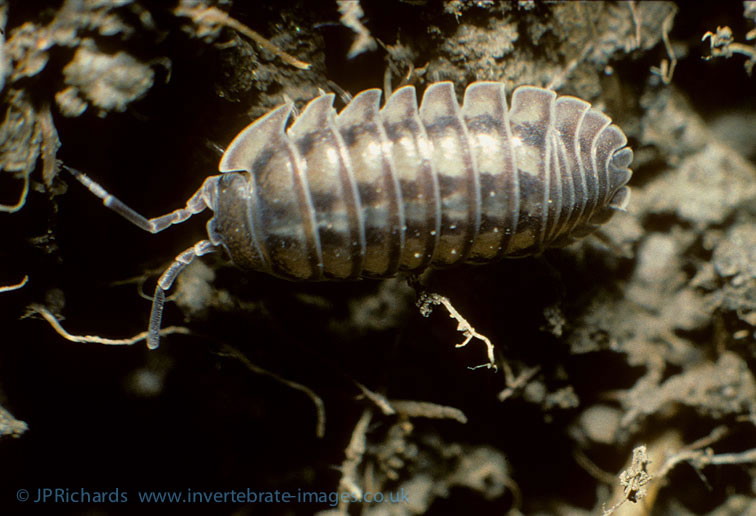Armadillidium nasatum Budde-Lund, 1885
Common name
Synonyms
Status:
GB IUCN status: Least Concern
ID Difficulty
Identification
Our seven Armadillidium species and Eluma caelata (Family Armadillidiidae) are readily recognised in the field by their truncated 'square' uropods that end flush with the body and their ability to roll into a protective sphere (similar truncated uropods are also seen in the non-native Armadillidae species).
Armadillidium nasatum is a large pill-woodlouse (to 12mm body length) is reminiscent of the common A. vulgare. However the narrow protruding scutellum (snout), reminiscent of the peak of a base-ball cap, is diagnostic. It usually has a dark grey body marked with pale longitudinal stripes that give a semi-translucent appearance, but dark and coloured forms may also be encountered. When disturbed it forms an imperfect ball, with its antennae protruding.
Distribution
Armadillidium nasatum occurs patchily across southern England and south Wales, but in recent decades it has spread further north with scattered 'outdoor' populations now known from West Lancashire (where first recorded in 2019), north-east Yorkshire (in 2023) and an outlying record from ‘waste ground’ near a garden centre in Northumberland (in 2024). Recently it has also been recorded from several garden centres in north-east England and the Lothians of south east Scotland (Maguire, 2023; pg 10-11). The northern-most record is from inside a glasshouse at Dundee Botanic Gardens where it was found by by Helen Bell in 2021. There is a handful of records from Ireland, where it is probably under-recorded, including recent discoveries in garden centres in Cos. Tyrone and Fermanagh (Maguire, 2023; pg 10-11) and Co. Carlow (by Ciarán Byrne). An updated distribution map is given in Gregory (2024).
Habitat
It is characteristic of dry, sparsely vegetated habitats, both semi-natural and synanthropic, that are subject to high levels of insolation. In more southern areas this includes coastal grassland, limestone screes, disused limestone quarries, railway lines, industrial waste ground and garden centres. Further north it becomes increasingly restricted to garden centres and inside greenhouses (Maguire, 2023; pg 10-11).
It is typically found under rocks, stones, pieces of wood, potted plants and other debris or amongst rubble, often with A. vulgare.
This summary is based on the detailed account in Gregory (2009), updated in Gregory (2024).
References
Gregory, S. (2009) Woodlice and Waterlice (Isopoda: Oniscidea & Asellota) in Britain and Ireland. Field Studies Council/Centre for Ecology & Hydrology.
Links
World List of Marine, Freshwater and Terrestrial Isopod Crustaceans: https://www.marinespecies.org/isopoda/aphia.php?p=taxdetails&id=257751








